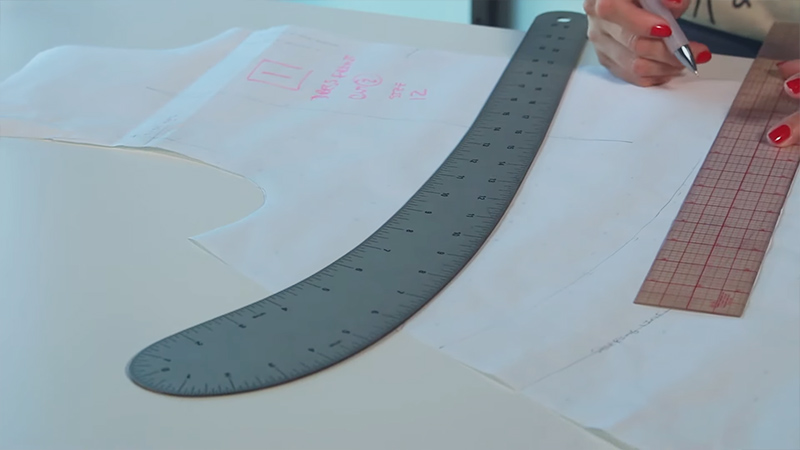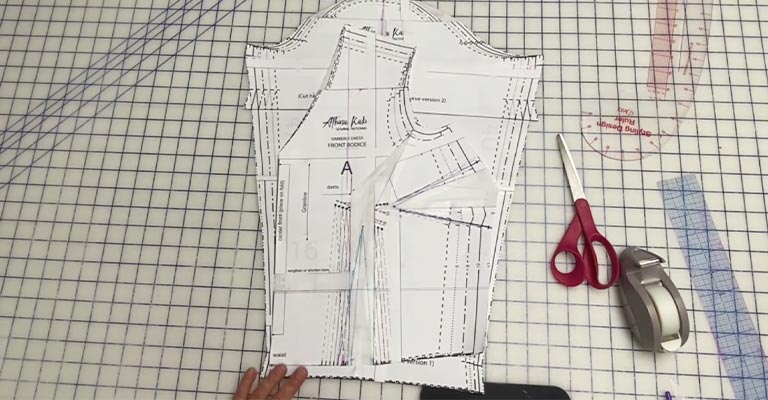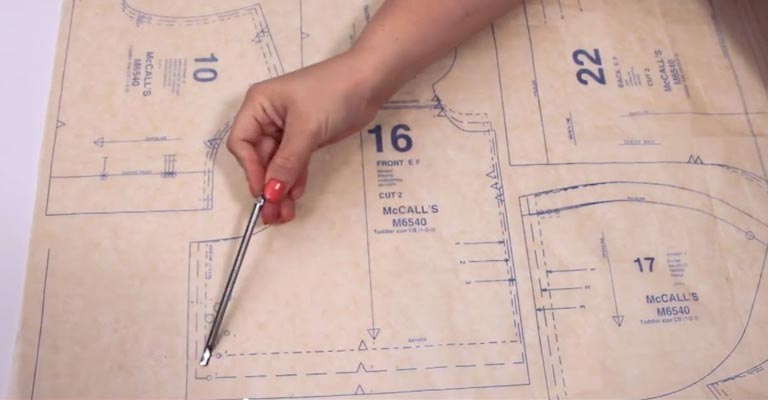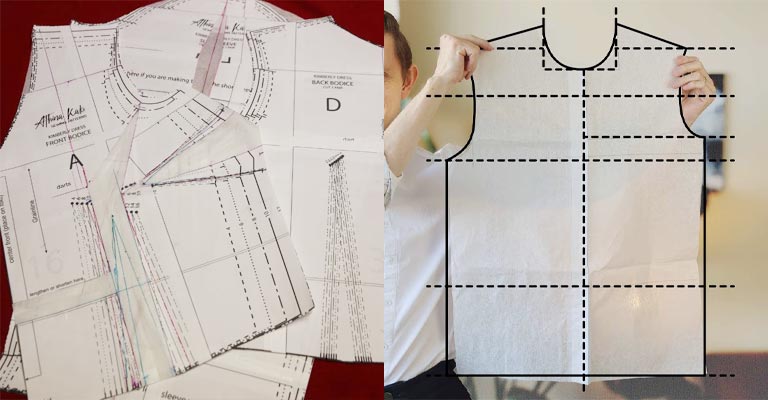Navigating the world of sewing patterns can be an exciting venture for anyone who loves creating their own clothing.
However, if you’re on the shorter side or have a more petite frame, the term “petite” on a sewing pattern becomes crucial.
But what exactly does “petite” signify in this context? In a nutshell, it’s a designation tailored to individuals with shorter heights and smaller proportions.
This label ensures that the clothing will fit impeccably, acknowledging the nuances of a petite figure.
In this exploration, we’ll delve into the precise meaning of “petite” in sewing patterns, how to determine if you need one, and how to make alterations for a perfect fit.

What Does Petite on a Sewing Pattern Mean?
“PETITE” on a sewing pattern is a term used to describe a specific sizing category tailored to individuals of shorter stature.
Sewing patterns are designed to cater to a wide range of body shapes and sizes, and “petite” sizing is just one of these categories.
Understanding what “petite” means on a sewing pattern is essential for achieving a well-fitting garment for those with shorter proportions.
Here are some key points to consider:
Height
Petite sizing primarily addresses height. A petite person is typically shorter than the average height for their gender.
However, it’s important to note that being petite doesn’t necessarily mean a person is small in every dimension (e.g., bust, waist, hips).
A petite individual could have a petite height but still have regular or plus-sized proportions in other areas of their body.
Proportions
While “petite” patterns focus on height, the proportions of a petite person can vary. Some petites might have shorter arms, a shorter torso, or shorter legs relative to their overall height.
These variations can influence the fit and comfort of a garment, and patterns designed for petites often take them into account.
Pattern Adjustments
When working with a sewing pattern labeled as “petite,” you’ll often find that the pattern pieces are scaled to accommodate shorter proportions.
This means that the pattern might have shorter bodices, sleeves, and inseams. However, it’s essential to understand that not all petite individuals have the same proportions, so further adjustments may be necessary to achieve a perfect fit.
Benefits
Using a petite sewing pattern can save time and effort in adjusting patterns, as the initial design is already tailored for shorter individuals. This can lead to a more accurate fit from the start and less need for extensive alterations.
Considerations
While “petite” patterns are a great starting point for shorter individuals, it’s important to remember that everyone’s body is unique.
A petite pattern might not fit perfectly without some additional modifications. To ensure a custom fit, it’s advisable to take accurate body measurements and make further alterations as needed, such as shortening or lengthening specific areas of the pattern.
How Are Petite Sizes Measured?

Petite sizes are meticulously measured to cater to individuals with shorter stature and smaller proportions.
The specific measurements for petite sizes are designed to ensure a well-fitted and flattering look for those who fall within this category.
Here’s a breakdown of how petite sizes are typically measured:
Height
Petite sizing begins with height. Typically, petite sizing is designed for individuals who are 5’4″ (162.5 cm) or shorter. This is the foundational parameter that sets petite sizes apart from standard sizes.
To accommodate shorter statures, petite garments feature shorter hemlines and inseams. This ensures that the clothing fits well and doesn’t look overly long on the wearer.
Bust
Petite sizing takes into account smaller bust measurements. The patterns are adjusted to fit individuals with smaller bust circumferences.
This feature is crucial in preventing the baggy or loose fit that can occur with standard patterns on petite frames.
Waist
Petite sizing also considers smaller waist measurements, recognizing the more petite waistlines of individuals in this category.
Garments with petite sizing will have a narrower waistband or waist measurement to ensure a snug, comfortable fit.
Hips
Petite sizes often feature smaller hip measurements as well. This adjustment ensures that the garments complement the proportions of those with petite frames, preventing any bagginess or excess fabric around the hips.
Sleeve Length
Sleeve lengths in petite patterns are shorter to ensure a proportional fit. This accounts for the shorter arm length typically found in petite individuals, preventing sleeves from being too long and creating an unbalanced look.
Shoulder Width
Petite patterns may incorporate narrower shoulder widths. This aligns with the overall proportion of petite frames, ensuring that the garment fits well and doesn’t bunch up at the shoulders.
Armhole Height
Petite patterns often have higher armholes, accommodating the shorter arm length while allowing for ease of movement. This detail prevents garments from feeling restrictive or causing discomfort.
Bodice Length
The bodice length in petite patterns is shorter to suit individuals with shorter torsos. This measurement ensures that the waistline of a dress or top aligns properly with the wearer’s natural waist.
Back Waist Length
The back waist length measurement is shorter in petite patterns, matching the shorter torsos common in petite individuals. This is crucial for achieving a proper fit around the waist area.
Inseam
Inseam measurements are shorter in petite patterns to cater to the shorter leg length of petite individuals. This adjustment prevents pants or skirts from dragging on the ground or looking excessively long.
Uses of Petite Patterns in Sewing

Petite patterns in sewing serve a vital role in catering to individuals with shorter stature and smaller proportions.
These specialized patterns offer several benefits and applications, making them indispensable for those who fall into the petite category:
Proportional Fit
The primary use of petite patterns is to provide a proportional fit for those with shorter frames. Standard sewing patterns are often designed for individuals of average height, which can result in garments that look oversized and unflattering on petite individuals.
Petite patterns address this issue by offering shorter hems, inseams, sleeves, and other measurements, ensuring that the final product fits impeccably and complements the wearer’s proportions.
Enhanced Comfort
Petite patterns go beyond aesthetics; they also enhance comfort. Clothing that fits properly is more comfortable to wear and move in.
Petite individuals can enjoy freedom of movement and comfort without the need to constantly adjust or alter store-bought garments.
Time and Effort Savings
Petite patterns can save considerable time and effort compared to altering regular patterns. Alterations like shortening hems or adjusting shoulder widths can be time-consuming and may not yield the same level of precision as using a pattern designed for petite proportions.
Confidence Boost
Well-fitting clothing enhances self-confidence. Petite patterns help petite individuals feel more confident in their appearance by ensuring that their garments fit properly, accentuate their features, and project a polished look.
Customization
Petite patterns provide a foundation for customization. While they are designed for shorter frames, individuals can still modify them to suit their unique preferences.
These patterns can serve as a canvas for creative alterations, from adjusting necklines to experimenting with different fabrics and embellishments.
Fashion Versatility
Petite patterns offer a wide range of fashion choices. Whether it’s casual wear, formal attire, or specialty garments like costumes or sportswear, petite patterns cover a broad spectrum of styles.
This versatility allows petite individuals to express their fashion tastes while ensuring an appropriate fit.
Economical
Sewing with petite patterns can be cost-effective in the long run. It eliminates the need to purchase expensive petite-sized clothing, which can be harder to find in stores. Sewing allows for more control over the budget, choice of fabrics, and style, resulting in both well-fitting and cost-efficient garments.
Sustainability
In the era of eco-consciousness, sewing with petite patterns contributes to sustainability. Creating garments that fit well and are made to last reduces the need for constant clothing replacements and minimizes fashion-related waste.
Difference Between Petite and Regular

The primary difference between petite and regular clothing lies in the sizing and proportions, tailored to accommodate individuals with distinct body types and heights.
Here’s a detailed comparison of petite and regular clothing:
Height
- Petite: Petite clothing is crafted for those who are 5’4″ and under. This height range often includes shorter individuals, and the garments are adjusted to prevent excess fabric at the hems or inseams. This ensures a harmonious look without the need for extensive alterations.
- Regular: Regular clothing caters to a broader height spectrum, typically from 5’4″ to 5’8″. The hems and inseams are longer to accommodate the taller individuals within this range.
Proportions
- Petite: Petite garments are designed with proportions that complement shorter frames. This means shorter torsos, narrower shoulders, and shorter arms. These adjustments ensure that the clothing sits well on petite bodies without overwhelming them.
- Regular: Regular clothing maintains the proportions suitable for an average height. This includes longer torsos, broader shoulders, and standard arm lengths.
Sleeve Length
- Petite: In petite clothing, sleeve lengths are shorter to accommodate the shorter arms of petite individuals. This prevents sleeves from appearing overly long and disproportionate.
- Regular: Regular clothing features sleeves designed for average arm lengths, which can be longer than those found in petite individuals.
Waist and Hip Measurements
- Petite: Petite clothing typically offers smaller waist and hip measurements, acknowledging the narrower waistlines and smaller hip circumferences of petite individuals.
- Regular: Regular clothing maintains standard waist and hip measurements that align with the typical body shape of individuals within the average height range.
Shoulder Width
- Petite: Shoulder widths in petite clothing are often narrower to match the narrower shoulders of individuals with shorter stature, ensuring a snug fit.
- Regular: Regular clothing provides broader shoulder widths, accommodating the wider shoulder proportions found in individuals within the average height range.
Back Waist Length
- Petite: Back waist length in petite clothing is shorter, aligning with the shorter torsos commonly seen in petite individuals. This ensures a well-fitted garment around the waist.
- Regular: Regular clothing features longer back waist lengths that suit the longer torsos typical of the average height range.
Inseam Length
- Petite: Inseams in petite clothing are shorter to match the shorter leg length of petite individuals, preventing pants and skirts from dragging on the ground.
- Regular: Regular clothing offers longer inseams, designed for individuals with average-length legs.
FAQS
Are petite sewing patterns only for women?
No, while petite patterns are commonly associated with women’s clothing, there are also petite sewing patterns available for men and children. These patterns cater to individuals of shorter stature and smaller proportions across genders.
Do petite sewing patterns only come in smaller sizes?
Petite sewing patterns typically include a range of sizes, just like regular patterns. The key difference is in the proportions and length adjustments to ensure a proper fit for shorter individuals.
Can I use a regular sewing pattern if I’m on the borderline of petite height?
If you’re on the borderline of petite height (around 5’4″), you may still prefer petite patterns for a more precise fit.
However, you can use regular patterns and make alterations to shorten the garment’s length if you’re confident in your sewing skills.
Are petite sewing patterns suitable for plus-size individuals with shorter stature?
Yes, there are petite sewing patterns available for plus-size individuals with shorter statures.
These patterns are designed to accommodate both the height and proportions of petite plus-size individuals.
Can I alter a regular sewing pattern to fit a petite frame?
Yes, it’s possible to alter a regular sewing pattern to fit a petite frame by adjusting measurements and lengths.
However, using a dedicated petite pattern can save time and effort by incorporating the necessary alterations for a better fit.
Wrap Up
In sewing, understanding what “petite” signifies on a sewing pattern is paramount for achieving a well-fitted, flattering wardrobe.
Petite patterns are meticulously tailored to the unique proportions of individuals with shorter stature and smaller frames.
They offer a proportional fit, with adjustments to hems, sleeves, and other dimensions, ensuring that the garments drape beautifully on petite frames.
Whether it’s about enhancing comfort, saving time and effort, boosting confidence, or unleashing creativity, petite sewing patterns play a crucial role.
They empower individuals to not only look their best but also embrace fashion versatility, customization, and sustainability. In a petite pattern, every stitch is a celebration of individuality and style.
Leave a Reply